Question
Correct position of floral parts over thalamus in mustard plant is [NEET (Oct.) 2020]
(a) gynoecium occupies the highest position, while the other parts are situated below it
(b) margin of the thalamus grows upward, enclosing the ovary completely and other parts arise below the ovary
(c) gynoecium is present in the centre and other parts cover it partially
(d) gynoecium is situated in the centre and other parts of the flower are located at the rim of the thalamus, at the same level
Answer/Explanation
Ans. (a)
Option (a) is correct. It can be explained as
A flower, has four different whorls arranged successively on the swollen end of the stalk or pedicel called thalamus or receptacle. In mustard, flower is hypogymous, i.e., the gynoecium occupies the highest position while the other parts are situated below it. The ovary in such flowers is said to be superior.
Question
Ray florets have [NEET (Sep.) 2020]
(a) superior ovary
(b) hypogynous ovary
(c) half inferior ovary
(d) inferior ovary
Answer/Explanation
Ans. (d)
Ray florets have inferior ovary as epigynous flowers have an inferior ovary with the flattened thalamus as seen in the ray florets of sunflowers. In epigynous flowers, all the floral parts are present above the gynoecium.Ovary has been covered completely by thalamus, e.g. guava, apple, sunflower.
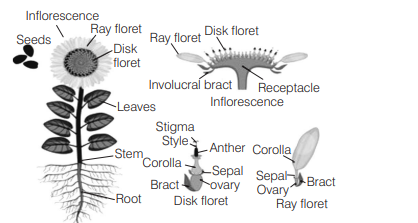
Question
The ovary is half inferior in [NEET (Sep.) 2020]
(a) mustard
(b) sunflower
(c) plum
(d) brinjal
Answer/Explanation
Ans. (c)
The ovary is half inferior in plum. It is a perigynous condition in which ovary is at the top (origin wise) and other whorls are at the same level (position wise).
There are three possible arrangements of attachment of floral whorls with thalamus where thalamus is disc-like, cup-shaped and flask-shaped.
Question
Placentation in which ovules develop on the inner wall of the ovary or in peripheral part, is [NEET (National) 2019]
(a) axile
(b) parietal
(c) free central
(d) basal
Answer/Explanation
Ans. (b)
In parietal placentation, the ovules develop on the inner wall of the ovary or in peripheral part. In this type, the ovary is compound or syncarpous type which is either unilocular or falsely two or more locular, e.g. mustard, Argemone, Fumaris, etc. Axial placentation is when ovules are placed along the central axis of the ovary.
Basal placentation is when ovules are placed at the base of the ovary.
Free-central placentation is when placenta develops at the centre of ovary as prolongation of floral axis. On this axis, the ovules are attached.
Question
Bicarpellary ovary with obliquely placed septum is seen in [NEET (Odisha) 2019]
(a) Brassica
(b) Aloe
(c) Solanum
(d) Sesbania
Answer/Explanation
Ans. (c)
Solanum (family Solanaceae) has bicarpellary ovary with obliquely placed septum. Brassica(family Brassicaceae) has bicarpellary ovary with false septum. In Sesbania(subfamily Fabaceae), ovary is monocarpellary. Aloe (family Liliaceae) shows tricarpellary ovary.
Question
Match the placental types (Column I) with their examples (Column II) [NEET (Odisha) 2019]
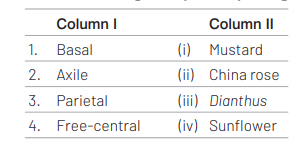
Select the correct option from the following
$\begin{array}{llll}1 & 2 & 3 & 4\end{array}$
(a) (ii) (iii) (iv) (i)
(b) (i) (ii) (iii) (iv)
(c) (iv) (ii) (i) (iii)
(d) (iii) (iv) (i) (ii)
Answer/Explanation
Ans. (c)
The correct matches are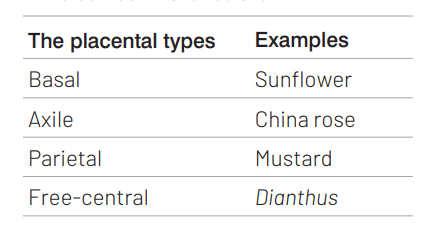
Question
The standard petal of a papilionaceous corolla is also called [NEET 2016, Phase I]
(a) pappus
(b) vexillum
(c) corona
(d) carina
Answer/Explanation
Ans. (b)
The standard or large upper petal of a papilionaceous corolla is also called vexillum.
Question
Tricarpellary, syncarpous gynoecium is found in flowers of [NEET 2016, Phase I]
(a) Solanaceae
(b) Fabaceae
(c) Poaceae
(d) Liliaceae
Answer/Explanation
Ans. (d)
Liliaceae represents $G_{(3)}$. This family includes plants like garlic, onion, tulip, indigo, etc.
Question
Free-central placentation is found in [NEET 2016, Phase II]
(a) Dianthus
(b) Argemone
(c) Brassica
(d) Citrus
Answer/Explanation
Ans. (a)
The plant Dianthus has free-central placentation in its ovary. Ovules are attached on the main axis of the placenta.
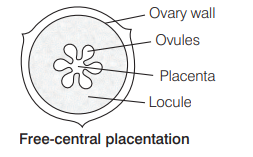
Question
Radial symmetry is found in the flowers of [NEET 2016, Phase II]
(a) Brassica
(b) Trifolium
(c) Pisum
(d) Cassia
Answer/Explanation
Ans. (a)
The Brassica flower can be cut into two equal halves from any plane. So, it shows the radial symmetry. These flowers are referred to as actinomorphic flowers.
Other flowers given in the option (Trifolium, Pisum and Cassia) can be cut into two equal halves only at one plane so they are called zygomorphic flowers. These three flowers belong to familyFabaceae.
Question
How many plants among Indigofera, Sesbania, Salvia, Allium, Aloe, mustard, groundnut, radish, gram and turnip have stamens with different lengths in their flowers? [NEET 2016, Phase II]
(a) Three
(b) Four
(c) Five
(d) Six
Answer/Explanation
Ans. (b)
Only Salvia, mustard, radish and turnip have stamens of different length in their flowers. Hence, correct answer is(b).
Question
The term ‘polyadelphous’ is related to [NEET 2016, Phase II]
(a) gynoecium
(b) androecium
(c) corolla
(d) calyx
Answer/Explanation
Ans. (b)
The term polyadelphous is related to androecium. In this condition, many stamens are present in more than 2 groups which are separated from each other.
Question
Flowers are unisexual in [CBSE AIPMT 2015]
(a) pea
(b) cucumber
(c) China rose
(d) onion
Answer/Explanation
Ans. (b)
Cucumber is a member of the family-Cucurbitaceae. In the members of this family, the flowers are unisexual, with male and female flowers on different plants (dioecious)or on thesame plant (monoecious).
Question
Axile placentation is present in [CBSE AIPMT 2015]
(a) dianthus
(b) lemon
(c) pea
(d) Argemone
Answer/Explanation
Ans. (b)
Placentation refers to the arrangement of ovules inside the ovary. In axile placentation, the ovules are axial as shown in the figure below.
Examples include, lemon, China rose and tomato.
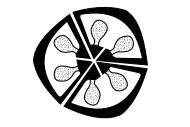
Question
Among China rose, mustard, brinjal, potato, guava, cucumber, onion and tulip, how many plants have superior ovary? [CBSE AIPMT 2015]
(a) Five
(b) $\mathrm{Six}$
(c) Three
(d) Four
Answer/Explanation
Ans. (b)
A superior ovary is an ovary attached to the receptacle above the attachment of other floral parts. In this case the flower is said to be hypogynous, e.g. China rose, mustard, brinjal, potato, onion and tulip. Guava and cucumber have inferior ovaries or epigynous flowers.
So, out of 8 given names, 6 have superior ovaries.
Question
Placenta and pericarp are both edible portions in [CBSE AIPMT 2014]
(a) apple
(b) banana
(c) tomato
(d) potato
Answer/Explanation
Ans. (c)
Tomato is botanically a fruit but it is considered as a vegetable for various purposes. Its edible parts are both placenta and pericarp. Placenta is the connecting tissue which supply nutrition for embryo and pericarp is the remains of ovular wall. It is rich in lycopene.
Question
When the margins of sepals or petals overlap one another without any particular direction, the condition is termed as [CBSE AIPMT 2014]
(a) vexillary
(b) imbricate
(c) twisted
(d) valvate
Answer/Explanation
Ans. (b)
Imbricate aestivation is the arrangements of five petals being arranged in such a way that one petal is completely external and another petal is completely internal, while three petals are partially external and partially internal, e.g. Cassia, Callistemon and Coesalpinia
Question
Among bitter gourd, mustard, brinjal, pumpkin, China rose, lupin, cucumber, sunnhemp, gram, guava, bean, chilli, plum, Petunia, tomato, rose, Withania, potato, onion, aloe and tulip, how many plants have hypogynous flower? [NEET 2013]
(a) Six
(b) Ten
(c) Fifteen
(d) Eighteen
Answer/Explanation
Ans. (c)
All the given plants except bitter gourd, pumpkin, cucumber, guava, plum and rose are hypogynous flower, i.e. 15. Hypogynous flower have gynoecium present above all other floral parts and with superior ovary.
Question
In China rose the flowers are [NEET 2013]
(a) actinomorphic, hypogynous with twisted aestivation
(b) actinomorphic, epigynous with valvate aestivation
(c) zygomorphic, hypogynous with imbricate aestivation
(d) zygomorphic, epigynous with twisted aestivation
Answer/Explanation
Ans. (a)
Actinomorphic (star-shaped) can be divided into 3 or more identical sections, which are related to each other by rotation about the centre of the flower, e.g. China rose.
Zygomorphic flowers can be divided by only a single plane into two mirror image halves, e.g. orchids.
Valvate aestivation The sepals or petals in a whorl just touch one another at the margin, e.g. Calotropis.
Twisted aestivation 0 ne margin of the appendage overlaps that of the next one, e.g. China rose. In Imbricate aestivation the margins of sepals or petals overlap but not necessarily in specific direction, e.g. Cassia.
Question
Placentation in tomato and lemon is [CBSE AIPMT 2012]
(a) parietal
(b) free central
(c) marginal
(d) axile
Answer/Explanation
Ans. (d)
Lemon or Citrus (family-Rutaceae), tqmato or Lycopersicon sp.
(family-Solanaceae), China rose or Hibiscus (family-Malvaceae) etc. have axile placentation. It occurs in multicarpellary, syncarpous ovary. Inward growth of margins of carpels forms a multicarpellary condition which contains an axis in the centre. Placentae arise from this central axis which bear ovules.
Question
Cymose inflorescence is present in [CBSE AIPMT 2012]
(a) Solanum
(b) Sesbania
(c) Trifolium
(d) Brassica
Answer/Explanation
Ans. (d)
Cymose inflorescence seen in Brassica is also called definite or determinate inflorescence because the growing point of the peduncle is used up in the formation of a flower. Further growth of the flowering axis is continued by one or more lateral branches (peduncles) which also end in flowers. This type of inflorescence is found in family-Solanaceae.
Question
The gynoecium consists of many free pistils in flowers of [CBSE AIPMT 2012]
(a) Aloe
(b) tomato
(c) Papaver
(d) Michelia
Answer/Explanation
Ans. (d)
Apocarpous condition arises when the number of carpels is two or more and they are free from each other. e.g. Clematis, Michelia(Magnoliaceae).
Aconitum, Ranunculus (buttercupl etc.
Question
Which one of the following statements is correct? [CBSE AIPMT 2011]
(a) Seeds of orchids have oil-rich endosperm
(b) Placentation in primrose is basal
(c) Flower of tulip is a modified shoot
(d) In tomato, fruit is a capsule
Answer/Explanation
Ans. (c)
The correct statement is ‘c’ because flower is highly condensed and modified shoot meant for sexual reproduction (Dr. Goethe; 1790). During the course of evolution, the nodes of the axis of shoot came in contact so, that internodes got reduced, and leaves get modified and specialised to form floral leaves.
Question
Flowers are zygomorphic in [CBSE AIPMT 2011]
(a) gulmohur
(b) tomato
(c) datura
(d) mustard
Answer/Explanation
Ans. (a)
When a flower can be divided into two similar halves only in one particular vertical plane, it is called zygomorphic, e.g. bean, pea, gulmohur, Cassia, etc.
Question
The ovary is half inferior in flowers of [CBSE AIPMT 2011]
(a) cucumber
(b) cotton
(c) guava
(d) peach
Answer/Explanation
Ans. (d)
If gynoecium is situated in the center and other parts of the flowers are located on the rim of the thalamus almost at the same level, it is called perigynous. The ovary here is said to be half inferior, i.e. plum rose, peach, etc.
Question
Keel is characteristic of the flowers of [CBSE AIPMT 2010]
(a) gulmohur
(b) Cassia
(c) Calotropis
(d) bean
Answer/Explanation
Ans. (d)
In bean-family the two-in-one petal is called the keel, like the keel of a boat. Bean blossoms with this configuration are said to be papilionaceous.
Question
In unilocular ovary with a single ovule, the placentation is [CBSE AIPMT 2010]
(a) marginal
(b) basal
(c) free central
(d) axile
Answer/Explanation
Ans. (b)
In basal placentation, ovary is bicarpellary, syncarpous and unilocular and a single ovule is borne at the base of ovary, e.g. marigold. In marginal placentation, the ovary is simple, unilocular and the ovules are arranged along the margin of the unilocular ovary, e.g. pea. In free central placentation, ovary is unilocular and the placenta bearing ovules arise from the central axis, e.g. Stellaria. In axile placentation, ovary is two or more chambered, usually as many as the number of carpels, e.g. Petunia.
Question
The technical term used for the androecium in a flower of China rose (Hibiscus rosa sinensis) is [CBSE AIPMT 2010]
(a) monadelphous
(b) diadelphous
(c) polyandrous
(d) polyadelphous
Answer/Explanation
Ans. (a)
In monadelphous condition, all filaments become fused and form a group, while anther remain free, e.g. China rose, Achyranthes, etc. In diadelphous, two separate bundles of united filaments are formed, e.g. pea. In polyadelphous, more than two separate bundles of filaments are formed, e.g. Ricinus.
Question
An example of axile placentation is [CBSE AIPMT 2009]
(a) Argemone
(b) Dianthus
(c) lemon
(d) marigold
Answer/Explanation
Ans. (c)
Lemon (Citrus sp.) belongs to family-Rutaceae, characterised by axile placentation.
Argemone belongs to
family-Papaveraceae, contains parietal placentation. Dianthus belongs to family-Caryophyllaceae, contains free-central placentation. Marigold belongs to family-Asteraceae, contains basal placentation.
Question
What type of placentation is seen in sweet pea? [CBSE AIPMT 2006]
(a) Axile
(b) Free central
(c) Marginal
(d) Basal
Answer/Explanation
Ans. (c)
In sweet pea(Pisum sativum), the placentation is marginal, in which, the placenta develops along the junction of two carpels, in a unilocular ovary.
In basal placentation, the ovules are few or reduced to one and are borne at the base of ovary e.g. Compositae.
In axile placentation, margins of carpels fold inwards, fusing together in centre of ovary to form a single central placenta. Ovary is divided into as many locules, as there are carpels, e.g. Hibiscus, Asphodelus. Free-central placentation possesses a placenta arises as a central upgrowth from ovary base, e.g. Stellaria.
Question
Long filamentous threads protruding at the end of the young cob of maize are [CBSE AIPMT 2006]
(a) styles
(b) ovaries
(c) hairs
(d) anthers
Answer/Explanation
Ans. (a)
In a cob of maize, each ovary has a long silky (hairy) style, called as corn silk. Collectively these styles protrude at the end of a young cob. The grains are formed on the cob which remain covered by the leafy bracts.
Question
Bicarpellary gynoecium and oblique ovary occurs in [CBSE AIPMT 2001]
(a) mustard
(b) banana
(c) Pisum
(d) brinjal
Answer/Explanation
Ans. (d)
Brinjal belongs to family-Solanaceae. Obliquely placed bicarpellary ovary is characteristic of Solanaceae. Obliquely placed bicarpellary ovary
Question
The type of placentation in which ovary is syncarpous, unilocular and ovules on sutures is called [CBSE AIPMT 1999]
(a) apical placentation
(b) parietal placentation
(c) marginal placentation
(d) superficial placentation
Answer/Explanation
Ans. (b)
Parietal placentation occurs in bicarpellary to polycarpellary
In basal placentation, the ovules are few or reduced to one and are borne at the base of ovary e.g. Compositae.
In axile placentation, margins of carpels fold inwards, fusing together in centre of ovary to form a single central placenta. Ovary is divided into as many locules, as there are carpels, e.g. Hibiscus, Asphodelus. Free-central placentation possesses a placenta arises as a central upgrowth from ovary base, e.g. Stellaria.
Question
Long filamentous threads protruding at the end of the young cob of maize are [CBSE AIPMT 2006]
(a) styles
(b) ovaries
(c) hairs
(d) anthers
Answer/Explanation
Ans. (a)
In a cob of maize, each ovary has a long silky (hairy) style, called as corn silk.
Collectively these styles protrude at the end of a young cob. The grains are formed on the cob which remain covered by the leafy bracts.
Question
Bicarpellary gynoecium and oblique ovary occurs in [CBSE AIPMT 2001]
(a) mustard
(b) banana
(c) Pisum
(d) brinjal
Answer/Explanation
Ans. (d)
Brinjal belongs to family-Solanaceae. Obliquely placed bicarpellary ovary is characteristic of Solanaceae. Obliquely placed bicarpellary ovary is characteristic of Solanaceae.
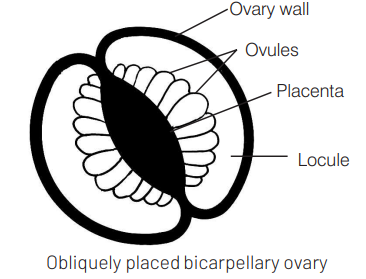
Question
The type of placentation in which ovary is syncarpous, unilocular and ovules on sutures is called [CBSE AIPMT 1999]
(a) apical placentation
(b) parietal placentation
(c) marginal placentation
(d) superficial placentation
Answer/Explanation
Ans. (b)
Parietal placentation occurs in bicarpellary to polycarpellary syncarpous pistils in which the ovary is unilocular. The placentae are formed along the fused margins of the carpels
from where the ovules arise. syncarpous pistils in which the ovary is unilocular. The placentae are formed along the fused margins of the carpelsfrom where the ovules arise.
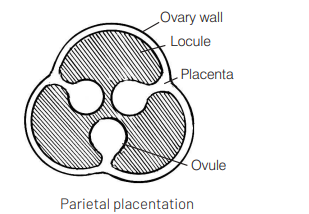
Question
Angiosperm to which the largest flowers belong is [CBSE AIPMT 1999]
(a) total stem parasite
(b) partial stem parasite
(c) total root parasite
(d) partial root parasite
Answer/Explanation
Ans. (c)
Rafflesia, a total root parasite, produces largest flower in the world.
Question
Floral features are chiefly used in angiosperms identification because [CBSE AIPMT 1998]
(a) flowers are of various colours
(b) flowers can be safely pressed
(c) reproductive parts are more stable and conservative than vegetative parts
(d) flowers are nice to work with
Answer/Explanation
Ans. (c)
Vegetative parts are relatively less stable and exhibit changes due to the environmental factors quite readily. On the other hand, floral features are more conservative and can be relied upon. On the basis of reproductive parts of different flowers Linnaeus classified plants into different groups.
$
Question
Which one yields fibre? [CBSE AIPMT 1988]
(a) Coconut
(b) Oak
(c) Teak
(d) Sissoo
Answer/Explanation
Ans. (a)
On the basis of their origin, commercial fibres are of three types : surface fibres (fibres obtained from seeds), e.g. cotton, coconut (coir), Calotropis, bast fibres (fibres present in phloem), e.g. Cannabis (hemp), Linum (flax), jute, sunnhemp, and leaf fibres (fibres extracted from leaves), e.g. Agave (sisal hemp), Musa (masnila hemp).
